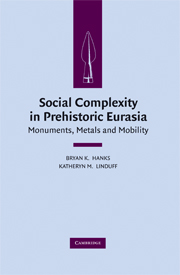Book contents
- Frontmatter
- Contents
- Contributors
- Foreword: From Myth to Method: Advances in the Archaeology of the Eurasian Steppe
- CHAPTER 1 Introduction: Reconsidering Steppe Social Complexity within World Prehistory
- PART ONE FRAMING COMPLEXITY
- CHAPTER 2 Introduction
- CHAPTER 3 Differentiated Landscapes and Non-uniform Complexity among Bronze Age Societies of the Eurasian Steppe
- CHAPTER 4 The Sintashta Genesis: The Roles of Climate Change, Warfare, and Long-Distance Trade
- CHAPTER 5 Settlements and Cemeteries of the Bronze Age of the Urals: The Potential for Reconstructing Early Social Dynamics
- CHAPTER 6 The Maikop Singularity: The Unequal Accumulation of Wealth on the Bronze Age Eurasian Steppe?
- PART TWO MINING, METALLURGY, AND TRADE
- PART THREE FRONTIERS AND BORDER DYNAMICS
- PART FOUR SOCIAL POWER, MONUMENTALITY, AND MOBILITY
- Index
CHAPTER 3 - Differentiated Landscapes and Non-uniform Complexity among Bronze Age Societies of the Eurasian Steppe
from PART ONE - FRAMING COMPLEXITY
Published online by Cambridge University Press: 26 January 2010
- Frontmatter
- Contents
- Contributors
- Foreword: From Myth to Method: Advances in the Archaeology of the Eurasian Steppe
- CHAPTER 1 Introduction: Reconsidering Steppe Social Complexity within World Prehistory
- PART ONE FRAMING COMPLEXITY
- CHAPTER 2 Introduction
- CHAPTER 3 Differentiated Landscapes and Non-uniform Complexity among Bronze Age Societies of the Eurasian Steppe
- CHAPTER 4 The Sintashta Genesis: The Roles of Climate Change, Warfare, and Long-Distance Trade
- CHAPTER 5 Settlements and Cemeteries of the Bronze Age of the Urals: The Potential for Reconstructing Early Social Dynamics
- CHAPTER 6 The Maikop Singularity: The Unequal Accumulation of Wealth on the Bronze Age Eurasian Steppe?
- PART TWO MINING, METALLURGY, AND TRADE
- PART THREE FRONTIERS AND BORDER DYNAMICS
- PART FOUR SOCIAL POWER, MONUMENTALITY, AND MOBILITY
- Index
Summary
Differentiated Eurasian Landscapes
Archaeological research increasingly illustrates that Bronze Age societies of the Eurasian steppe were inherently more diverse in their ways of life than their related material culture might imply (D. Zdanovich 1997 ; Kosintsev 2001 ; Nelin 2000 ; Epimakhov 2003). Bronze Age steppe communities illustrate comparatively different scales of social, economic, and political organization, as well as local variability in their extents of mobility and geographic ranges of interaction (e.g., Anthony et al. 2005 ; Chernykh 2004 ; Shishlina 2003 ; Frachetti 2008a). Even in local settings, evidence suggests that Bronze Age steppe communities were organizationally heterogeneous – meaning they were not politically or economically centralized under a shared corpus of functional institutions. Yet widespread distribution of related forms of material culture has prompted archaeologists to define an expansive cultural community through the broad lens of culture history and economic interaction throughout the second millennium bce. One may observe that the emergence of a seemingly extensive socio-economic landscape throughout the Bronze Age stands at odds with the organizationally small-scale and locally rooted societies that occupied this vast territory. Current archaeological models of social complexity to date do not adequately fit the Bronze Age conditions evident across the Eurasian steppe zone (see Koryakova 2002). The apparent disjuncture between the scale of socio-political institutions of steppe populations and the geographic extent of their functional economic arena provides a unique case for the investigation of alternative models of interaction and social complexity among regional communities.
- Type
- Chapter
- Information
- Social Complexity in Prehistoric EurasiaMonuments, Metals and Mobility, pp. 19 - 46Publisher: Cambridge University PressPrint publication year: 2009
- 16
- Cited by



